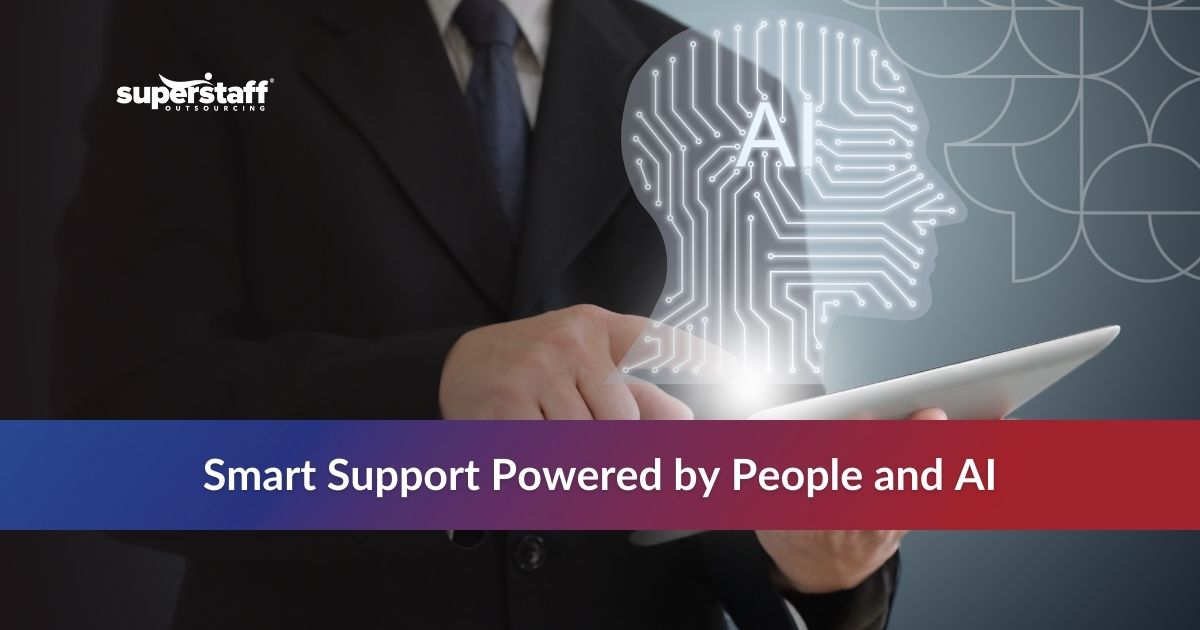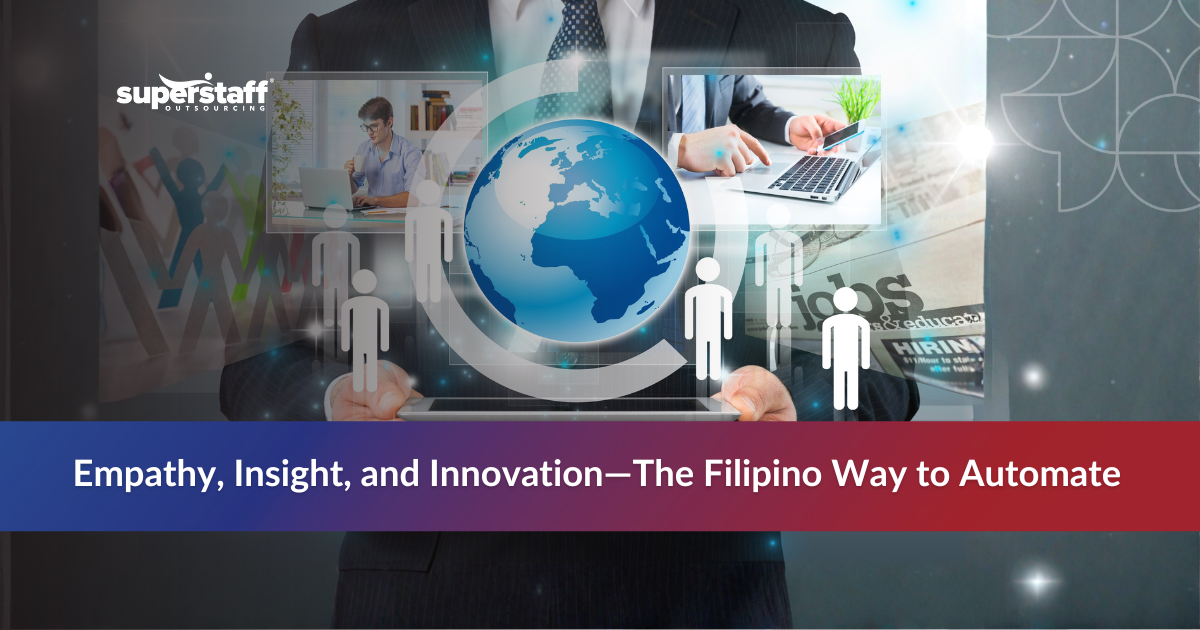
AI is transforming customer service—but it doesn’t mean replacing humans. The rise of smart tools like chatbots, natural language processors, and predictive engines has shifted customer expectations around speed, personalization, and availability. But even as automation takes center stage, companies are realizing that the most powerful approach in 2025 is a hybrid one. The real standout isn’t pure automation or all-human support—it’s a combination. This blog explores why the Human + AI customer support model is setting the new standard and how businesses can bring it to life through outsourcing.
AI Brings Speed, Scale, and Data Power to the Support Experience

AI customer support has redefined what speed and efficiency look like. Automated chatbots and voice assistants now respond to inquiries instantly, managing hundreds of interactions in parallel. The immediacy alone can transform the customer experience, especially for e-commerce and high-volume industries. But beyond fast replies, AI also excels at analyzing massive data sets in real time, allowing for smarter decision-making during support interactions.
Predictive models anticipate customer needs and offer personalized solutions. Whether it’s recommending the next best action or routing urgent cases to the right department, AI customer support enhances resolution paths with minimal delay. It lightens the load on agents, handling order updates, password resets, and basic FAQs—tasks that used to clog queues and burn out teams.
Even more impactful is how AI flags issues based on customer tone. If a chatbot detects rising frustration, it can escalate to a live agent instantly. This doesn’t just save time; it prevents churn. While AI manages routine volume, it clears the way for human agents to focus on more value-driven tasks.
Human Agents Bring Emotional Intelligence, Complex Thinking, and Trust
Despite its power, AI customer support can’t replicate human empathy. Some scenarios demand more than answers—they require emotional connection. Whether it’s a billing problem, a delayed delivery, or a medical inquiry, customers want to feel heard, not just processed.
That’s why humans remain indispensable. A skilled agent adapts their tone, reads context, and navigates difficult conversations—something no script or algorithm can do with the same finesse. This is especially vital in industries like healthcare or financial services, where stakes are high and compliance is critical.
When things get complex, people still prefer people. AI can gather information or initiate a process, but agents resolve layered, context-heavy issues that need reasoning and negotiation. This human element builds trust—something automation still struggles to earn.
As AI customer support expands, it’s not about replacing agents—it’s about empowering them to do what they do best. The handoff between AI and humans needs to be seamless, and when done right, customers don’t just get faster service—they get better service.
The Human + AI Model Improves KPIs Across the Board
One of the biggest reasons companies are embracing AI customer support is because it directly impacts performance metrics. Average handling time drops when AI collects initial information or surfaces solutions for agents in real time. Instead of starting from scratch, support reps jump into interactions with context, speeding up resolutions.
Customer satisfaction and Net Promoter Scores also rise when service blends responsiveness with empathy. AI customer support ensures consistency, while agents provide the relational depth that customers still crave. Together, they deliver a smoother, more meaningful journey.
First-contact resolution improves significantly. By using AI to triage and identify root causes before an agent gets involved, companies solve more problems in a single touchpoint. Agents, in turn, become more efficient when equipped with AI-powered CRMs and dynamic knowledge bases.
These gains aren’t theoretical—they’re already being seen by businesses that have committed to this hybrid model. It’s not about flashy technology. It’s about building a system that balances automation with authentic connection.
Outsourcing Partners Are Critical to Scaling the Human + AI Model
For most companies, adopting AI customer support at scale isn’t something they can do alone. Outsourcing provides an ideal solution. A strong BPO partner brings not just the talent, but the infrastructure needed to support a hybrid model from day one.
Top outsourcing providers offer agents who are trained to use AI tools fluently. They understand how to interpret AI prompts, collaborate with bots, and step in strategically. These aren’t just customer service reps—they’re part of an integrated ecosystem that unites technology with human insight.
Additionally, outsourcing companies help with the heavy lifting of integration. From setting up chatbots to connecting AI engines with ticketing systems or CRMs, these providers streamline deployment. And because they work across industries, they bring tested playbooks that save time and reduce risk.
Cost-wise, outsourcing makes a lot of sense. Rather than building everything in-house, companies can quickly scale support through an external team that’s already AI-ready. For fast-growing companies or those experimenting with new tech, this flexibility is key.
Blended Support Journeys Combine AI Efficiency and Human Nuance
To understand how AI customer support works alongside humans, imagine a common scenario: a traveler books a flight online. A chatbot confirms the itinerary and sends details instantly. The process is smooth and fast.
But then the flight gets canceled. The customer wants to rebook, ask about refunds, and figure out new transport. That’s when a human agent steps in—someone who can listen, empathize, and provide reassurance during a stressful moment. AI took care of the basics, but the human connection ensures satisfaction.
This dynamic happens across industries. In healthcare, AI might confirm an appointment or provide lab results. But if a patient is worried about symptoms, they need a nurse or care coordinator to talk it through. That human conversation builds comfort and trust.
These aren’t separate workflows—they’re part of a single, blended journey. AI handles what it does best: speed and data. Humans bring clarity and compassion when it matters most.
Successful Implementation Requires Training, Tech Alignment, and Feedback Loops
You can’t just plug in AI and expect magic. For AI customer support to succeed, agents need proper training. They must understand how to collaborate with automation, when to intervene, and how to leverage AI-generated suggestions.
Tech systems also need to work together. AI should feed insights into the same tools agents use—ticketing dashboards, CRMs, and help desks. If the data is fragmented, the customer experience suffers.
Outsourcing providers often lead this charge, offering onboarding programs tailored to hybrid teams. They help businesses align tech and talent quickly and ensure feedback loops are in place. AI learns from patterns, and human supervisors review those patterns to refine rules, adjust thresholds, and improve future interactions.
This cycle of continuous improvement keeps the Human + AI model sharp. As customer expectations evolve, so too does the blend of automation and support.
The Future of Customer Support Is Not Automation—It’s Augmentation
Looking ahead, the future of customer service isn’t about replacing people with tech—it’s about equipping them. AI customer support isn’t a stopgap measure. It’s a long-term strategy to meet rising customer demands with precision and personality.
Emerging tools will enhance this model even more. Think real-time language translation that eliminates language barriers. Or smarter AI engines that adjust tone based on a customer’s mood. These advancements will make every support interaction feel more tailored—more human, even if it begins with a bot.
This vision defines the future of customer service. It’s not about man vs. machine. It’s about how AI and humans work together in customer support—complementing each other in ways that amplify strengths and reduce friction.
Businesses that adopt this mindset now will gain more than faster service. They’ll earn loyalty, increase retention, and scale sustainably.
Getting Started With the Human + AI Model Through Outsourcing
Building this model starts with assessing where your support system stands. Are agents overwhelmed? Are routine inquiries slowing you down? If yes, it’s time to explore what AI customer support can do when combined with a skilled outsourcing team.
Start with areas where AI offers quick wins—like live chat or smart routing. Then, as your data builds, expand to more sophisticated tools. What matters most is choosing a partner who understands the full journey, not just the tech.
Ask if they offer AI onboarding, what kind of training they provide, and how they protect customer data. These aren’t minor details—they’re foundational to making the model succeed.
Outsourcing gives businesses the flexibility to test, refine, and grow without overcommitting resources. And with a BPO partner that understands AI customer support, your team can deliver a better experience—without burnout.
Why AI Customer Support Is the Future of Outsourced Success
The Human + AI model isn’t just a passing trend—it’s the most effective, scalable, and human-centered way to deliver modern customer service. AI customer support brings speed, structure, and insight. Human agents provide trust, empathy, and real problem-solving. Together, they drive results no single approach could achieve alone.
If your business is ready to embrace a support model that balances efficiency with care, SuperStaff is here to help. We train hybrid-ready agents and work closely with companies to implement AI tools that enhance—not replace—the human touch. Let’s build a support system that wins in 2025 and beyond—together.






